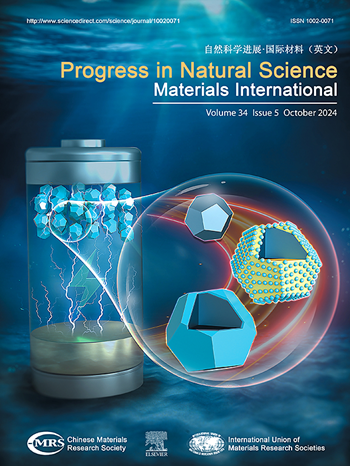Microstructure and mechanical properties of nickel-based wrought superalloys under thermal-mechanical coupling: A review with Inconel 718, 625 as main cases
IF 7.1
2区 材料科学
Q2 MATERIALS SCIENCE, MULTIDISCIPLINARY
Progress in Natural Science: Materials International
Pub Date : 2025-02-01
DOI:10.1016/j.pnsc.2024.12.001
引用次数: 0
Abstract
The typical processing and in-service behaviors of nickel-based wrought superalloys involve complex thermal-mechanical coupling effects, including elastic and plastic deformations, phase transformations, and other microstructural evolutions, directly impacting the mechanical properties. This review article provides an in-depth discussion on the microstructural evolution of these superalloys under thermal-mechanical coupling, focusing on two key aspects: the thermoplastic deformation behavior, and the phase transformation behavior in temperature/stress coupled field. The dynamic recrystallization (DRX) behavior during hot deformation and its improvement strategies are discussed in detail. The differences in phase precipitation behavior under conventional heat treatment and thermal-mechanical coupling conditions are compared. The mechanisms driving changes in precipitate characteristics are explored, enabling precise control of precipitates. This article further investigates the intricate relationship between the mechanical properties of nickel-based wrought superalloys and the characteristics of their precipitates, offering guidance for current and future optimizations. It also delves into the latest research advancements in precisely tailoring the precipitates through thermal-mechanical coupling methods to optimize these mechanical properties. Finally, it outlines several promising future research directions in this field.
热-力耦合作用下镍基变形高温合金的组织与性能:以Inconel 718、625为主要案例
镍基变形高温合金的典型加工和使用行为涉及复杂的热-力耦合效应,包括弹塑性变形、相变和其他微观组织演变,直接影响其力学性能。本文对高温合金在热-力耦合作用下的显微组织演变进行了深入的讨论,重点讨论了热-力耦合作用下的热塑性变形行为和相变行为两个关键方面。详细讨论了热变形过程中的动态再结晶(DRX)行为及其改进策略。比较了常规热处理和热-力耦合条件下相析出行为的差异。探讨了驱动析出物特征变化的机制,实现了对析出物的精确控制。本文进一步研究了镍基变形高温合金的力学性能与其析出相特征之间的复杂关系,为当前和未来的优化提供指导。它还深入研究了通过热-机械耦合方法精确定制析出物的最新研究进展,以优化这些机械性能。最后,对该领域未来的研究方向进行了展望。
本文章由计算机程序翻译,如有差异,请以英文原文为准。
求助全文
约1分钟内获得全文
求助全文
来源期刊
CiteScore
8.60
自引率
2.10%
发文量
2812
审稿时长
49 days
期刊介绍:
Progress in Natural Science: Materials International provides scientists and engineers throughout the world with a central vehicle for the exchange and dissemination of basic theoretical studies and applied research of advanced materials. The emphasis is placed on original research, both analytical and experimental, which is of permanent interest to engineers and scientists, covering all aspects of new materials and technologies, such as, energy and environmental materials; advanced structural materials; advanced transportation materials, functional and electronic materials; nano-scale and amorphous materials; health and biological materials; materials modeling and simulation; materials characterization; and so on. The latest research achievements and innovative papers in basic theoretical studies and applied research of material science will be carefully selected and promptly reported. Thus, the aim of this Journal is to serve the global materials science and technology community with the latest research findings.
As a service to readers, an international bibliography of recent publications in advanced materials is published bimonthly.

 求助内容:
求助内容: 应助结果提醒方式:
应助结果提醒方式:


